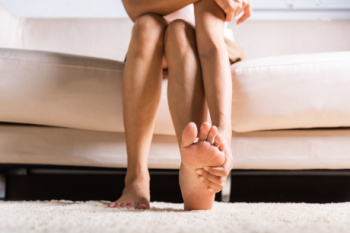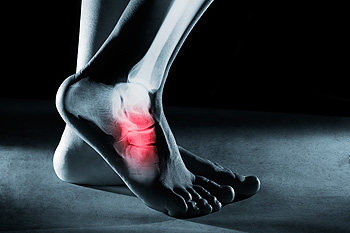
The feet are often overlooked, but they can provide important insights into overall health. Many symptoms occur in the feet before they are noticed elsewhere in the body. For instance, changes in foot appearance or structure, such as swollen or red feet, may indicate underlying issues like heart disease or diabetes. Conditions like athlete’s foot, fungal infections, or bunions are common signs of foot problems, while persistent foot pain can suggest joint issues, such as arthritis or gout. In some cases, poor circulation in the feet can be an early sign of peripheral artery disease or diabetes. Numbness, tingling, or changes in skin color may indicate nerve damage or systemic health issues. By paying attention to these signals and seeking early treatment, individuals can prevent more serious health problems. It is suggested that you consult a podiatrist when unusual symptoms arise. This type of doctor can treat various foot conditions and provide valuable insight into one’s overall well-being.
When dealing with systemic disease of the feet, it is extremely important to check the affected areas routinely so that any additional problems are caught quickly. If you have any concerns about your feet and ankles contact one of our podiatrists from Riznyk Podiatry. Our doctors will assist you with all of your podiatric needs.
Systemic Diseases of the Feet
Systemic diseases affect the whole body, and symptoms usually are displayed in the feet. This condition can make a patient’s ability to walk unbearable. Systemic diseases include gout, diabetes mellitus, neurological disorders, and arthritis.
Gout – is caused by an excess of uric acid in the body. Common symptoms include pain, inflammation, and redness at the metatarsal/phalangeal joint of the base big toe. Gout can be treated by NSAIDs to relieve pain and inflammation, and other drugs that lower the acid levels in the body.
Diabetes mellitus – is an increase in the level of blood sugar that the body cannot counteract with its own insulin. Failure to produce enough insulin is a factor in Diabetes.
Diabetes of the Feet
Diabetic Neuropathy – may lead to damaged nerves and affect the feet through numbness and loss of sensation.
Peripheral Vascular Disease – can restrict the blood flow to the feet, and often times lead to amputation of the feet.
If you have any questions please feel free to contact our office located in Orchard Park, NY . We offer the newest diagnostic and treatment technologies for all your foot and ankle needs.

Wearing shoes that are too tight can lead to various foot problems that affect the feet, toes, and ankles. Tight shoes create excessive pressure and friction, which may result in painful corns and calluses. These thickened areas of skin develop as a protective response to repeated irritation, often on the tops, sides, or bottoms of the feet. Ingrown toenails occur when tight footwear forces the nail into the surrounding tissue, leading to pain, swelling, and possible infection. Bunions, which are enlargements of the joint at the base of the big toe, can also develop or worsen due to wearing tight shoes. This condition often causes the big toe to press against adjacent toes, resulting in discomfort and inflammation. Additionally, tight shoes can lead to hammer toes, a deformity that causes toes to bend at the middle joint, making it challenging to wear shoes comfortably. A podiatrist can assess your foot issues and provide personalized treatment to relieve pain and prevent further complications. If you have foot pain that may be caused by wearing ill-fitting shoes, it is suggested that you schedule an appointment with a podiatrist for an exam and treatment.
It is important to find shoes that fit you properly in order to avoid a variety of different foot problems. For more information about treatment, contact one of our podiatrists from Riznyk Podiatry. Our doctors will treat your foot and ankle needs.
Proper Shoe Fitting
Shoes have many different functions. They cushion our body weight, protect our feet, and allow us to safely play sports. You should always make sure that the shoes you wear fit you properly in order to avoid injuries and deformities such as: bunions, corns, calluses, hammertoes, plantar fasciitis, stress fractures, and more. It is important to note that although a certain pair of shoes might be a great fit for someone else, that doesn’t mean they will be a great fit for you. This is why you should always try on shoes before buying them to make sure they are worth the investment. Typically, shoes need to be replaced ever six months to one year of regular use.
Tips for Proper Shoe Fitting
The shoes you buy should always feel as good as they look. Shoes that fit properly will last longer, feel better, and improve your way of life each day.
If you have any questions, please feel free to contact our office located in Orchard Park, NY . We offer the newest diagnostic and treatment technologies for all your foot care needs.

Running is an excellent exercise, but it can lead to various foot problems. Blisters are common, usually caused by friction from wearing ill-fitting shoes or socks. Toenail damage, including bruising or loss, can result from repeated pressure or tight shoes. Bunions are bony bumps on the side of the foot and often develop due to poor footwear or abnormal foot mechanics. Plantar fasciitis, a painful inflammation of the tissue on the bottom of the foot, is common in runners who overuse their feet or wear inadequate shoes. To prevent these issues, it is important to wear well-fitting shoes designed for running, choose moisture-wicking socks, and stretch before and after runs. If you have sustained a foot or ankle injury from running, it is suggested that you consult a podiatrist who can provide running injury prevention techniques and treatment.
All runners should take extra precaution when trying to avoid injury. If you have any concerns about your feet, contact one of our podiatrists of Riznyk Podiatry. Our doctors will treat your foot and ankle needs.
How to Prevent Running Injuries
There are a lot of mistakes a runner can make prior to a workout that can induce injury. A lot of athletes tend to overstretch before running, instead of saving those workouts for a post-run routine. Deep lunges and hand-to-toe hamstring pulls should be performed after a workout instead of during a warmup. Another common mistake is jumping into an intense routine before your body is physically prepared for it. You should try to ease your way into long-distance running instead of forcing yourself to rush into it.
More Tips for Preventing Injury
If you have any questions, please feel free to contact our office located in Orchard Park, NY . We offer the newest diagnostic and treatment technologies for all your foot care needs.

A stress fracture in the foot is a hairline crack in a bone, often caused by repetitive stress or overuse. This condition is common among athletes, particularly runners, and can also affect individuals who suddenly increase their activity level or engage in high-impact sports. The primary cause is the continuous pressure placed on the foot without adequate rest, leading to bone fatigue. Symptoms of a stress fracture typically include localized pain, swelling, and tenderness, especially during activity. The pain may initially subside with rest but return when activity resumes. To diagnose a stress fracture, a podiatrist will perform a physical exam and may use imaging tests, such as MRI scans to confirm the injury. Early diagnosis is essential to prevent further damage and ensure proper healing through rest, immobilization, or other treatments. If you have foot pain, it is suggested that you contact a podiatrist who can accurately provide a diagnosis and treatment.
Stress fractures occur when there is a tiny crack within a bone. To learn more, contact one of our podiatrists from Riznyk Podiatry. Our doctors can provide the care you need to keep you pain free and on your feet.
How Are They Caused?
Stress fractures are the result of repetitive force being placed on the bone. Since the lower leg and feet often carry most of the body’s weight, stress fractures are likely to occur in these areas. If you rush into a new exercise, you are more likely to develop a stress fracture since you are starting too much, too soon. Pain resulting from stress fractures may go unnoticed at first, however it may start to worsen over time.
Risk Factors
Stress fractures do not always heal properly, so it is important that you seek help from a podiatrist if you suspect you may have one. Ignoring your stress fracture may cause it to worsen, and you may develop chronic pain as well as additional fractures.
If you have any questions, please feel free to contact our office located in Orchard Park, NY . We offer the newest diagnostic and treatment technologies for all your foot care needs.